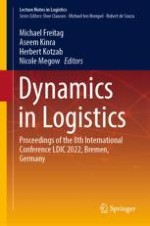Since 2007, the biennial International Conferences on Dynamics in Logistics (LDIC) offers researchersand practitioners from logistics, operations research, production, industrial and electrical engineering aswell as from computer science an opportunity to meet and to discuss the latest developments in thisparticular research domain. From February 23th to 25th 2022 for the eighth time, LDIC 2022 was held inBremen, Germany. Similar to its seven predecessors, the Bremen Research Cluster for Dynamics inLogistics (LogDynamics) organized this conference. The spectrum of topics reaches from the dynamicmodeling, planning and control of processes over supply chain management and maritime logistics toinnovative technologies and robotic applications for cyber-physical production and logistics systems.LDIC 2022 provided a forum for the discussion of advances in that matter. The conference programconsisted of keynote speeches and research papers selected by a severe double-blind reviewing process.Within these proceedings all the papers are published. By this, the proceedings give an interdisciplinaryoutline on the state of the art of dynamics in logistics as well as identify challenges and solutions forlogistics today and tomorrow.
